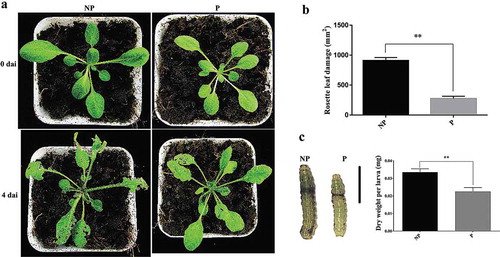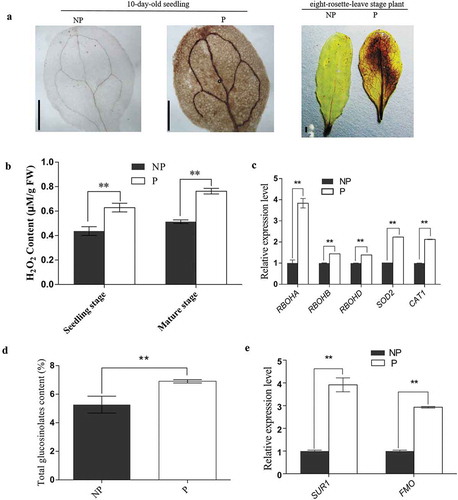Figures & data
Figure 1. Sodium chloride primes Arabidopsis plants against Spodoptera litura larval feeding.
Arabidopsis eight-rosette-leave plants were fed by second instar larvae of Spodoptera litura (Fabricius). (a) Primed plants and non-primed plants on the fourth day after infestation. (b) Rosette leaf damage caused by larval feeding in primed plants and non-primed plants. (c) Larval growth assessment after feeding on primed plants and non-primed plants. The scale bar represents 5 mm. Ten larvae were used to calculate mean values and standard deviations. Feeding assay was replicated above 3 times. Error bars indicate the standard deviation. ** differences are highly significant (P < .01) by Dunnett’s multiple comparison test. dai: days after infection by larvae. NP: non-primed plants; P: primed plants.

Figure 2. Primed defense responses of Arabidopsis aos and myc2 mutants.
Arabidopsis eight-rosette-leave plants were fed by second instar larvae of Spodoptera litura (Fabricius). (a) Primed plants and non-primed plants on the fourth day after infestation. (b) Rosette leaf damage measurement by ImageJ. (c) Larvae on the fourth day after infestation; the scale bar represents 5 mm. (d) Larval growth assessment after feeding on primed plants and non-primed plants. Ten larvae were used to calculate mean values and standard deviations. Feeding assay was replicated above 3 times. (e) Relative expression levels of VSP2 in primed plants and non-primed plants in wild type Col-0 and two mutants, aos and myc2. Error bars indicate the standard deviation. ** differences are highly significant (P< .01) by Dunnett’s multiple comparison test. dai: days after infection by larvae. NP: non-primed plants; P: primed plants.

Figure 3. ROS and GSL in non-primed and primed plants.
(a) DAB staining of leaves from Arabidopsis seedlings and mature plants with (P) or without (NP) 100 mM NaCl for 10 days; DAB staining of non-primed or primed plants at eight-rosette-leave stage. The scale bar represents 1 mm. (b) H2O2 content in non-primed plants. (c) Relative expression levels of RBOHA, RBOHB, RBOHC, SOD2 and CAT1 in non-primed and primed Arbidopsis at eight-rosette-leave stage. (d) Total glucosinolate content in Arabidopsis at eight-rosette-leave satge. (e) The expression of key genes SUR1 and FMO (FMOGS-OX3) related to glucosinolate synthesis in leaves of non-primed and primed plants at eight-rosette-leave stage. All tests were replicated three times. Error bars indicate the standard deviation. **differences are significant (P < .01) by Dunnett’s multiple comparison test.

